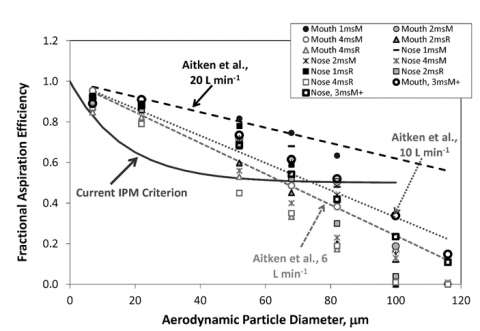An Empirical Model of Human Aspiration in Low Velocity Air Using CFD Investigations
T. Renée Anthony and Kimberly R. Anderson
Published in the Journal of Occupational and Environmental Hygiene at:
http://oeh.tandfonline.com/doi/pdf/10.1080/15459624.2014.970273
Update: This paper was recognized at AIHce 2016, in Baltimore, MD, as the "Best Paper" in the Journal of Occupational and Environmental Hygiene!
ABSTRACT
Computational fluid dynamics (CFD) modeling was performed to investigate the aspiration efficiency of the human head in low velocities to examine whether the current inhaled particulate mass (IPM) sampling criterion matches the aspiration efficiency of an inhaling human in airflows common to worker exposures. Data from both mouth and nose inhalation, averaged to assess omnidirectional aspiration efficiencies, were compiled and used to generate a unifying model to relate particle size to aspiration efficiency of the human head. Multiple linear regression was used to generate an empirical model to estimate human aspiration efficiency and included particle size as well as breathing and freestream velocities as dependent variables. A new set of simulated mouth and nose breathing aspiration efficiencies were generated and used to test the fit of empirical models. Further, empirical relationship between test conditions and CFD estimates of aspiration were compared to experimental data from mannequin studies, including both calm-air and ultralow velocity experiments. While a linear relationship between particle size and aspiration is reported in calm air studies, the CFD simulations identified a more reasonable fit using the square of particle aerodynamic diameter, which better addressed the shape of the efficiency curve’s decline toward zero for large particles. The ultimate goal this work was to develop an empirical model that incorporates real-world variations in critical factors associated with particle aspiration in order to inform low velocity modifications to the inhalable particle sampling criterion.
Raw Data by Test Condition, Compared to Mannequin Study Recommendations (Aitken et al.)
